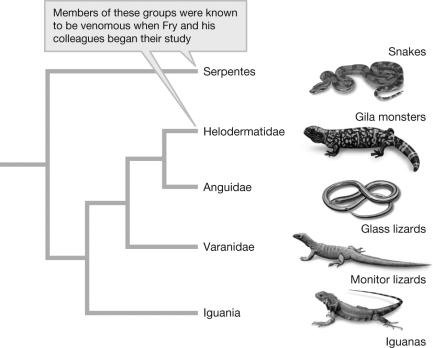The figure shows the phylogeny of snakes, Gila monsters, and their relatives. If venom production in snakes and Gila monsters is a homologous trait, would you expect to find venom production in other lizards and iguanas? 
A) No. Gila monsters share a common ancestor with other lizards and iguanas, but not with snakes; therefore, the presence of venom production in snakes and Gila monsters does not allow us to hypothesize about venom production in other species.
B) No. Homologous traits do not evolve easily; therefore, we would not expect other species to have evolved venom production.
C) Yes. If venom is homologous, then the common ancestor of snakes and Gila monsters would have produced venom and it is likely that the other descents of that ancestor would also produce venom.
D) Yes. Because snakes and Gila monsters independently evolved venom production, it seems likely that other lizards and iguanas would also be able to evolve venom production.
Correct Answer:
Verified
Q17: Based on the phylogenetic tree, which of
Q18: In the figure, the shrublike or treelike
Q19: If the tree shown in the figure
Q20: Which of the following is Carolus Linnaeus
Q21: Aposematic, or warning, coloration in poison frogs
Q23: The figure shows (A) a cladogram of
Q24: Examine the tree of life of all
Q25: Analogous traits are found in two or
Q26: Phylogenies can be used to distinguish homologous
Q27: The figure shows where tetrapod limbs evolved
Unlock this Answer For Free Now!
View this answer and more for free by performing one of the following actions

Scan the QR code to install the App and get 2 free unlocks

Unlock quizzes for free by uploading documents